- New Products
- Exclusive Gear
- Bushcraft Gear
- Containers
- Cooking
- Fire
- First Aid
- Food Gathering
- Knives & Tools
- Knife Collectors Corner
- Light
- Logo Gear
- Misc. Items
- Navigation
- Packs, Pouches & Bags
- Personal Care
- Repair Gear
- Shelter & Protection
- Signaling
- Urban Survival
- Water
- Writing Gear
- John's Books
- Bargain Bin
Handgun Training For Survival
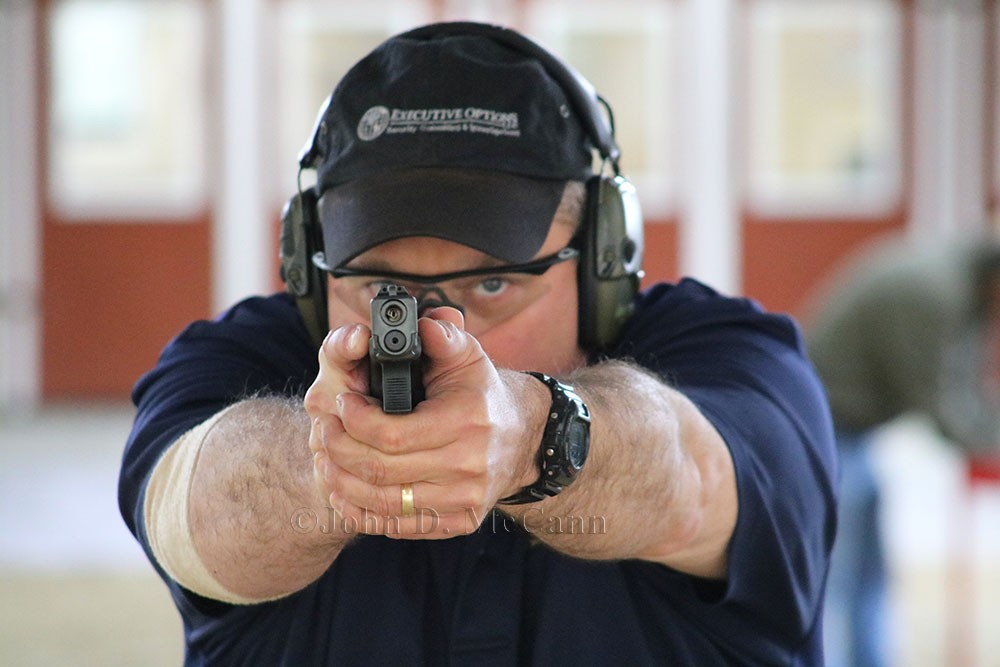
Today, the world has become a much more dangerous place to live. We have terrorism, civil unrest, increased criminal violence to include armed robbery, and in some cases, because of the direction of some in society, violence simply for purpose of violence. Because of this, many more people are arming themselves with a handgun for personal protection.
Carrying a handgun, with the intention of defending yourself with it, is a serious decision. There is more to it than just strapping a gun to your hip. There are legal ramifications in the event that you actually use that handgun and take someone's life. I frequently hear the old adage, "I would rather be tried by twelve than carried by six." This may sound good in theory, but does not make an adequate defense in a criminal case. And even if you are cleared of any criminal charges, you can still have a civil suit brought against you. You might lose everything you have ever worked for if you lose that lawsuit. For many, there are also mental ramifications in connection with the taking of a life. These variables cannot be taken lightly. Therefore proper training, including understanding the legalities of shooting another person, are essential for a person that carries a handgun for protection.
When I talk to people who indicate they carry a handgun, I often ask what type of training they have had, and how often do they train. I am often told that they go to a range on occasion and practice shooting at paper targets. Others shoot at targets in their yard to include cans.
Although practicing hitting a paper target provides for accuracy, in my opinion, in never allows a person to leave their comfort zone. When a real situation occurs, you most likely will not be shooting at a stationary target, and your target just might be shooting back. For this reason, as well as others, I believe that if you are training for survival a Defensive Handgun Course is in order.
Enlist An Expert
When I decided to do this article, I went to an old friend of more than twenty years, Don Redl, Jr., who is based here in New York. Don has been named a "Tactician" from the American Tactical Shooting Association, the sponsor of the National Tactical Invitational where he has consistently been recognized as one of the top 5 participants for many years, and was named the "Shotist" in 1999 making him a "National Champion". Don has personally trained numerous Law Enforcement, and Corporate Security professionals in Executive Protection, Firearms and Scenario Based Force on Force Training. I used him as my primary tactical firearms instructor for a firm I owned years ago, that among other things, provided specialized training to executive protection teams.
Today he runs Executive Options LLC., which not only provides specialized services to include executive protection, but also offers training programs to include Defensive Handgun, Protector Pistol, and Tactical Pistol. He also offers more extensive courses such as Conducting Cover and Evacuation Exercises at "Danger Close" distances. These more advanced courses use Simunition FX which is a marking cartridge and is fired from a standard firearm. Using this ammunition requires the installation of a drop-in conversion kit that does not permanently alter the weapon and can be easily removed. These kits ensure that normal service rounds cannot be fired during training and allow the use of the Simunition ammunition that work with reduced-pressure/reduced-velocity. We were using this technology over twenty years ago to ensure realistic and effective, reality-based training.
Get The Right Training
I find that when students attend courses that are required in order to get a CCW, they are only there to get through it. Basically, the qualification requirements are pre-defined, therefore the training program becomes “outcome based” and creates a teach the test mentality.
In the alternative, a Defensive Handgun Course is a "performance based" training program whereby standards are a way of measuring performance. Standards should NOT be something that can be easily achieved and/or considered a qualification. Standards should be a system of measurement that reinforces the “performance based” training program that gives the student a medium to self assess, a system that rewards improvement, and also identifies weaknesses, gaps and/or training scars. Standards should include both Objective and Subjective tests.
Objective Standards should be documentable, difficult, plausible and in use by a verifiable entity that uses a performance based training program. Both tests compartmentalize specific tasks, i.e. contact, mid range and extended distances, strong hand only, support hand only, turns, pivots, multiple targets and movement, all under challenging time allotments. Both tests are challenging, comprehensive and reward success as well as identify specific areas that need improvement.
Subjective Standards are best attained through realistic scenario based force-on-force training. One thing that has been consistent throughout the years is that victims of a lifetime of outcome based training, when put under the stress of scenario based force-on-force training normally fall apart, and then because they have never done anything other than “qualify,” they make excuses for their lack of performance. These are the people who unload everything they have and score zero hits on intended targets. That just might mean a lot of hits on unintended targets.
What I like about the Defensive Handgun Course offered by Don Redl, Jr., is that students must make both a time, and financial, commitment to better themselves. As a result, they make the greatest gains in the shortest amount of time. At the end of the day, they leave with skills and abilities in place that they were never aware existed prior to the course.
The course starts at eight-thirty in the morning and runs until four-thirty. The number of students for effective individual attention is twelve or less, although Don feels that the ideal number is four to six. I like that even though the range for this course is outside, it is completely covered overhead which makes training easier for the students during inclement weather.
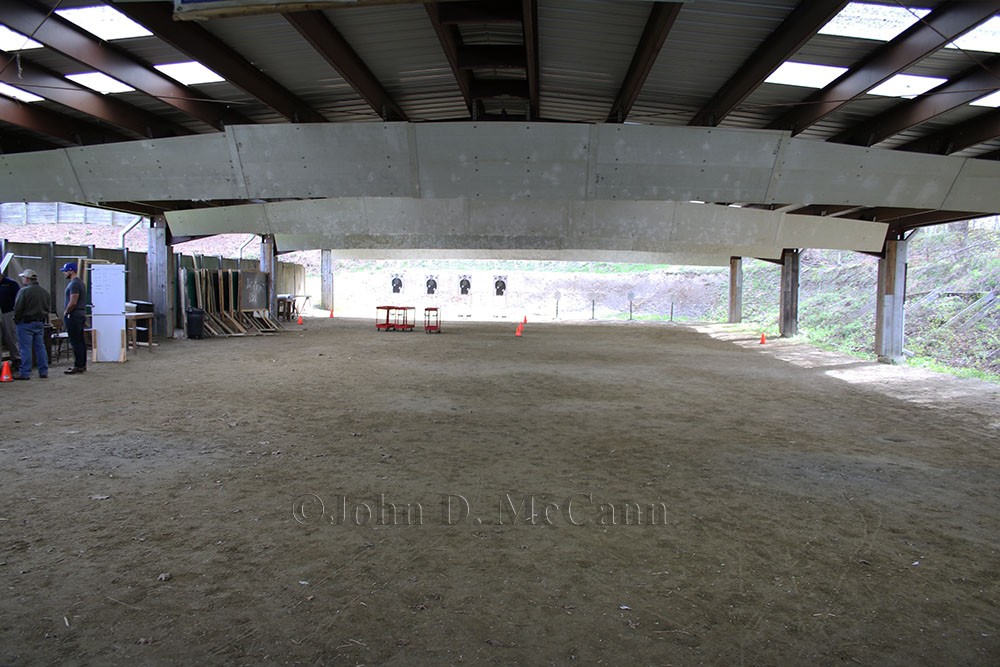 A view of the covered outdoor range making training easier during inclement weather.
A view of the covered outdoor range making training easier during inclement weather.
“Defensive Handgun Course” Defined
The objectives of the Defensive Handgun Course are many. It includes the safe and effective Draw, Presentation, and Re-holstering techniques, Loading, Unloading, Reloading, and Malfunction drills. Students perform contact distance shooting at distances five feet and under, and confrontational distance shooting at distances of ten feet and less. Vertical tracking shot placement, two hand supported and single hand shooting techniques, proactive self-defense shooting techniques, reactive self defense shooting techniques, accurate single and multiple shot placement, how to engage multiple targets, how to move and shoot, self analysis techniques, and properly use the sights in situation specific situations. This course is both thorough and fast paced.
The course I attended consisted of four students, three male and one female. Three of the four students were new gun owners and wanted to become proficient with their guns before carrying them. The fourth had been carrying for a while, but had only shot at paper targets and wanted more realistic training in the event he actually had to use his gun in a defensive situation.
Each student was required to have a minimum of four hundred rounds and at least, one spare magazine. All students had three or more. My primary function on the day of the course, other than document what was being taught, was to take photographs for this article. That became a monumental task, especially during live fire, and I came back with over sixteen-hundred photographs to choose from.
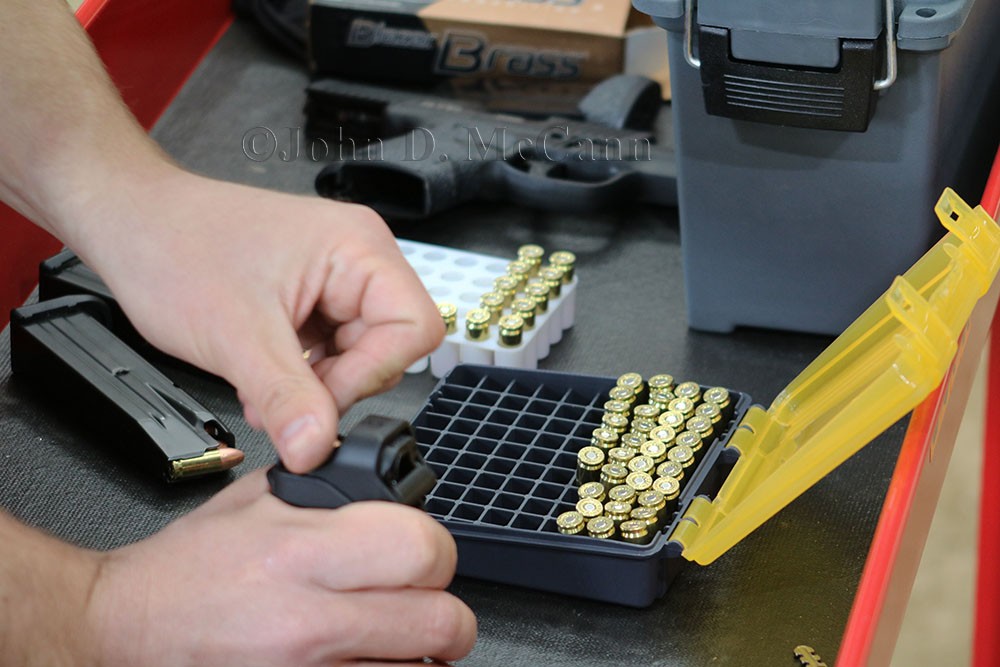 Because of the amount of ammo used during this course, there was a lot of re-loading magazines by students.
Because of the amount of ammo used during this course, there was a lot of re-loading magazines by students.
The first thing on the agenda for the day was a safety briefing, and range rules. No guns were to be un-holstered behind the firing line. If a gun was not in a holster it had to be benched in a manner that immediately revealed that the gun was in a safe condition. Inert "Blue" guns would be used initially to practice safe and effective draw, presentation, and re-holstering techniques.
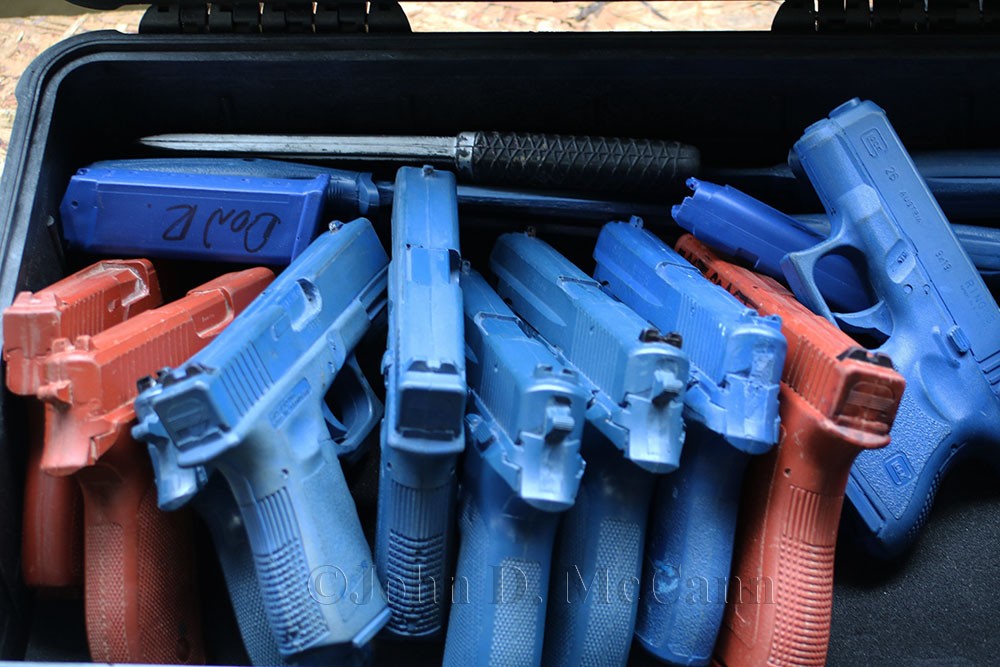 Inert "Blue" guns are a must for anyone who is serious about their training and were used during the
Inert "Blue" guns are a must for anyone who is serious about their training and were used during the
Defensive Handgun Course.
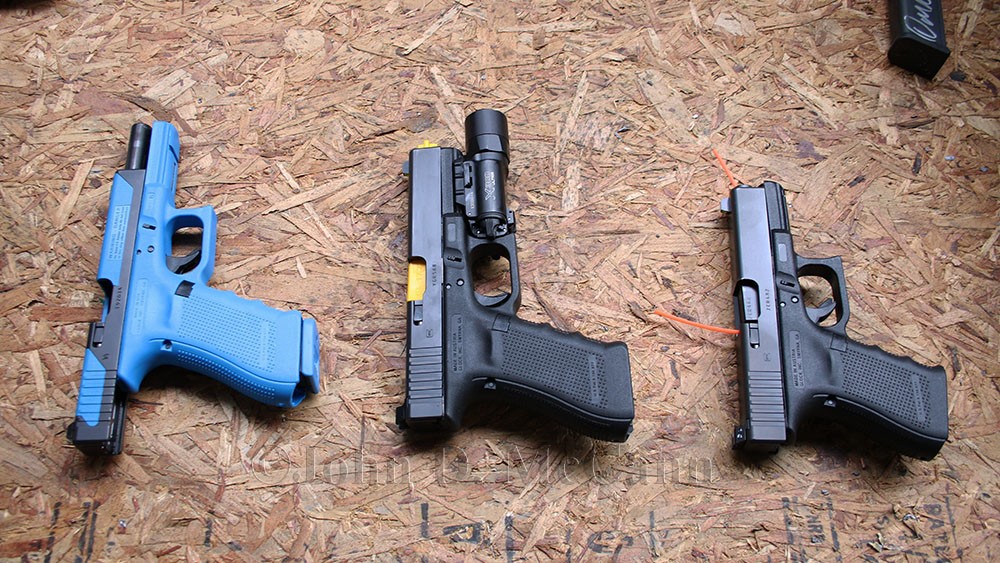
Guns not holstered behind the firing line mush be properly benched. On the left is a Glock 17T, which
is not only for Force-On-Force courses, but is used for demo purposes as well. The center shows a
Blade Tech barrel for dry fire training, and the right shows a gun with an empty chamber
indicator, which can be used when a gun is benched.
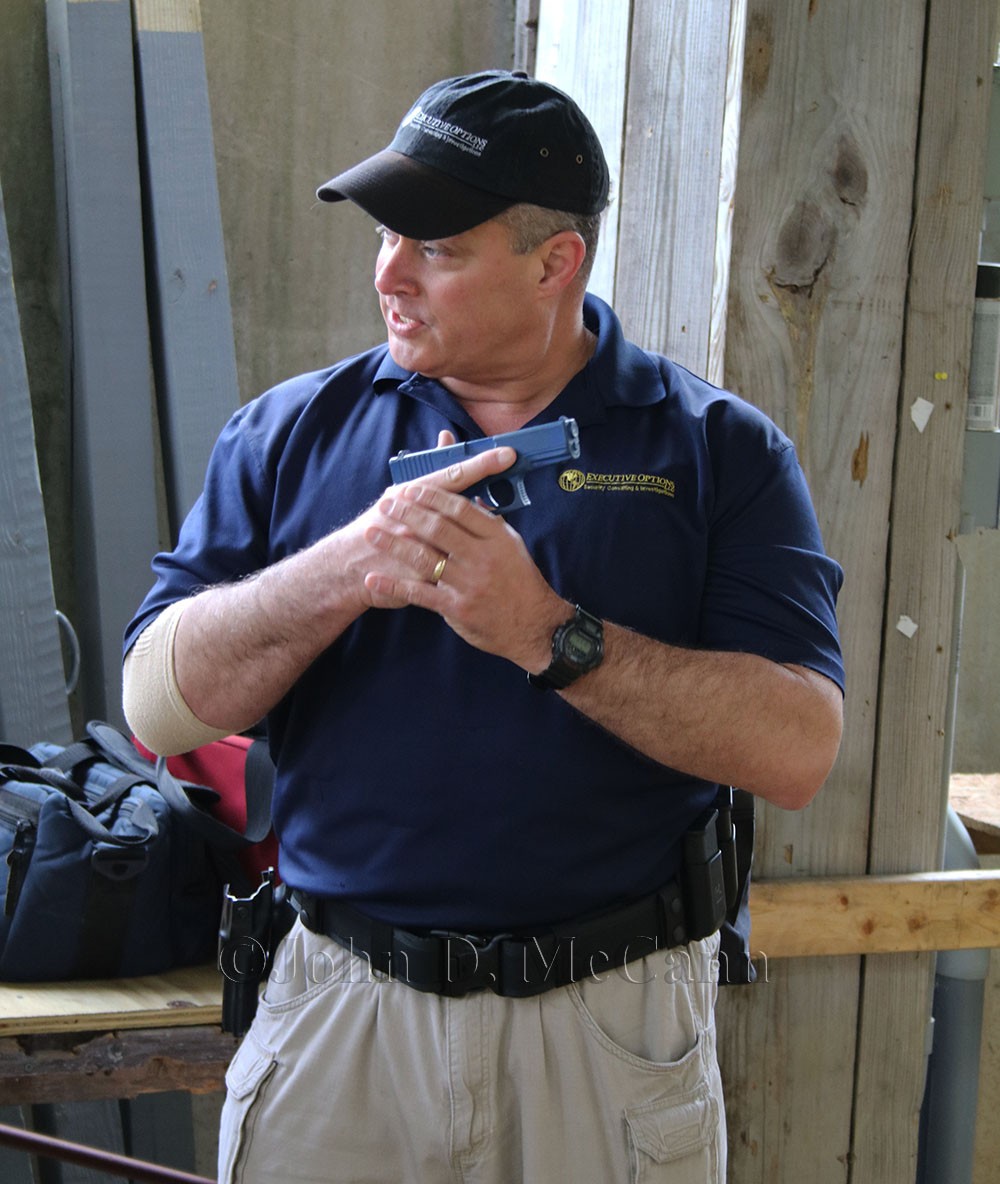 Don Redl, Jr. give the early morning safety briefing.
Don Redl, Jr. give the early morning safety briefing.
After the safety briefing, Don commenced with a discussion on proper handgun fit, holsters, grip and stance, sight alignment, trigger control and re-set, as well as defensive draw, presentation, and re-holstering.
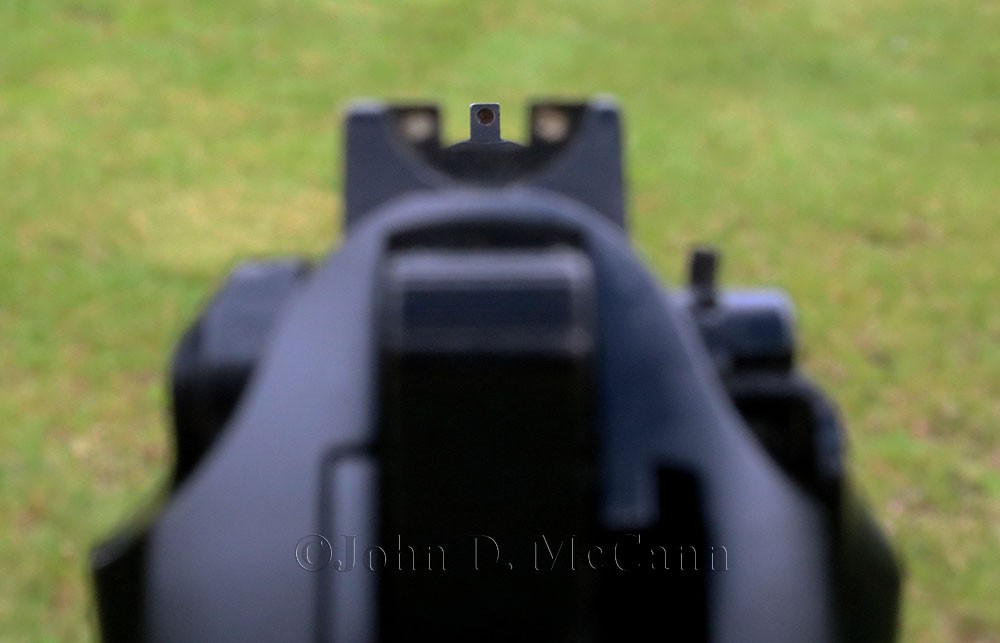 This photo shows proper sight alignment with front sight in focus.
This photo shows proper sight alignment with front sight in focus.
The Drills
Initially, students worked on paper targets with one shot drills, two shot drills, two shot emergency reload drills, and managing malfunctions. Vertical tracking drills were also performed.
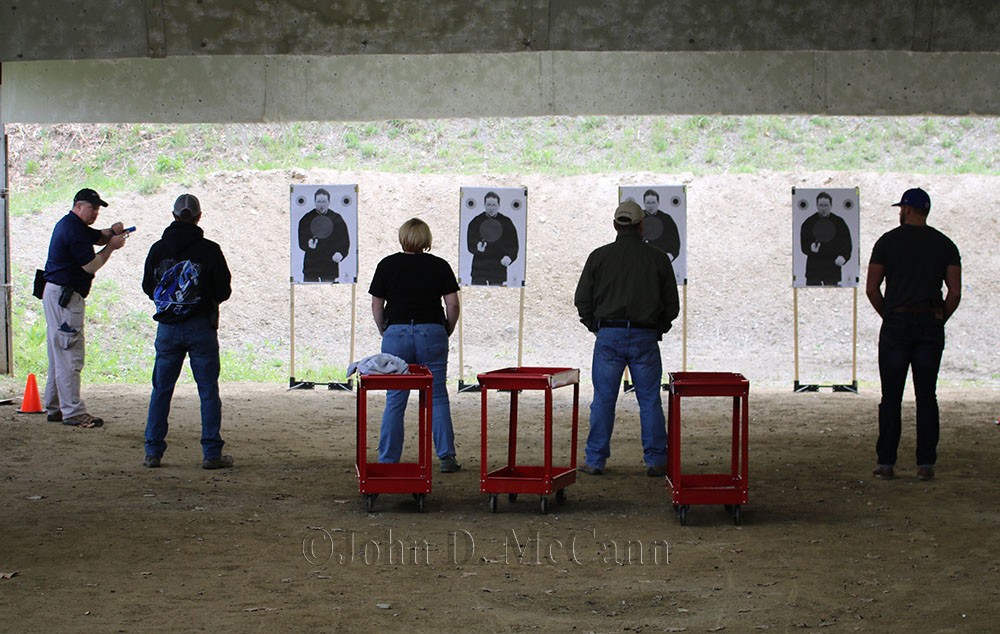 Students at paper targets for loading, unloading, reloading and managing malfunctions drills.
Students at paper targets for loading, unloading, reloading and managing malfunctions drills.
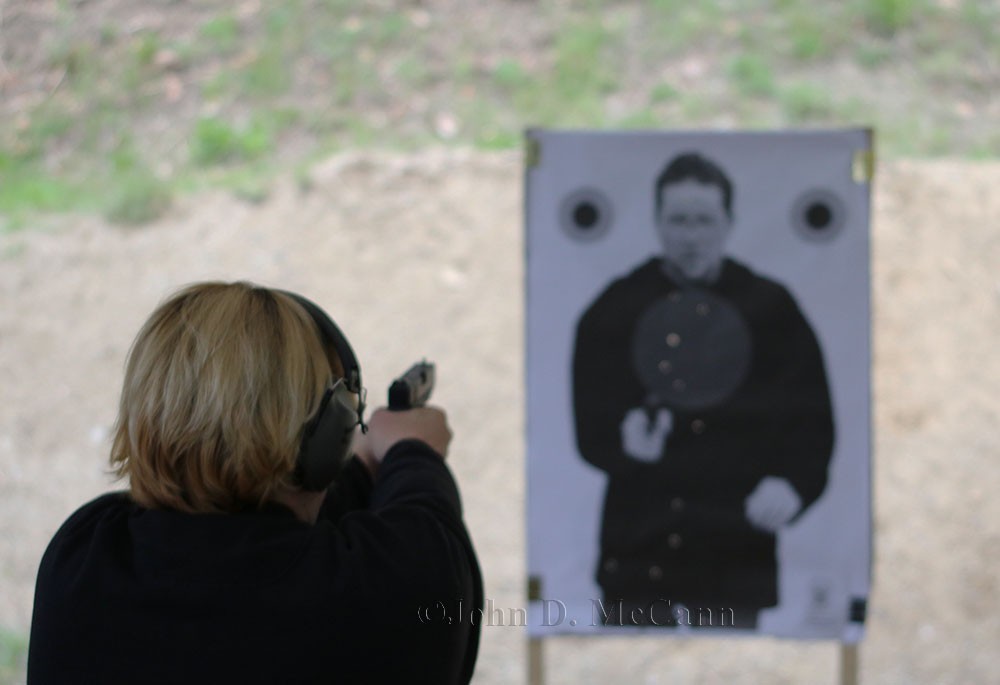 Student engaging a paper target.
Student engaging a paper target.
The paper targets measure accuracy, but you have to wait for feedback. Therefore, steel targets were next on the agenda for immediate feedback of firing exercises. Next on the agenda were "Movement Drills" designed to maximize the students ability to engage the threat with the appropriate level of force while minimizing personal injury. Bad guys, by definition always initiate the conflict, therefore their actions place you in a reactive position from the start. If you allow yourself to be put in a reactive position and kept there you will never be able to overcome the force being used against you. You must, in order to survive "turn the tables" on your attacker, or attackers, with aggressive proactive offensive-defensive techniques forcing them into a reactive position.
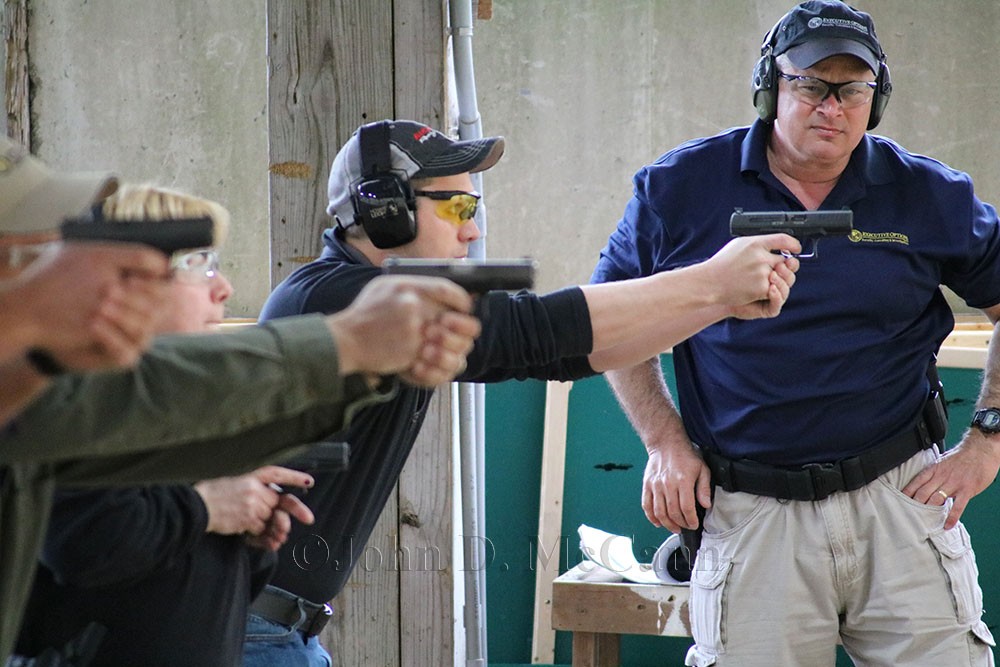 Don Redl, Jr. observing the Firing Line.
Don Redl, Jr. observing the Firing Line.
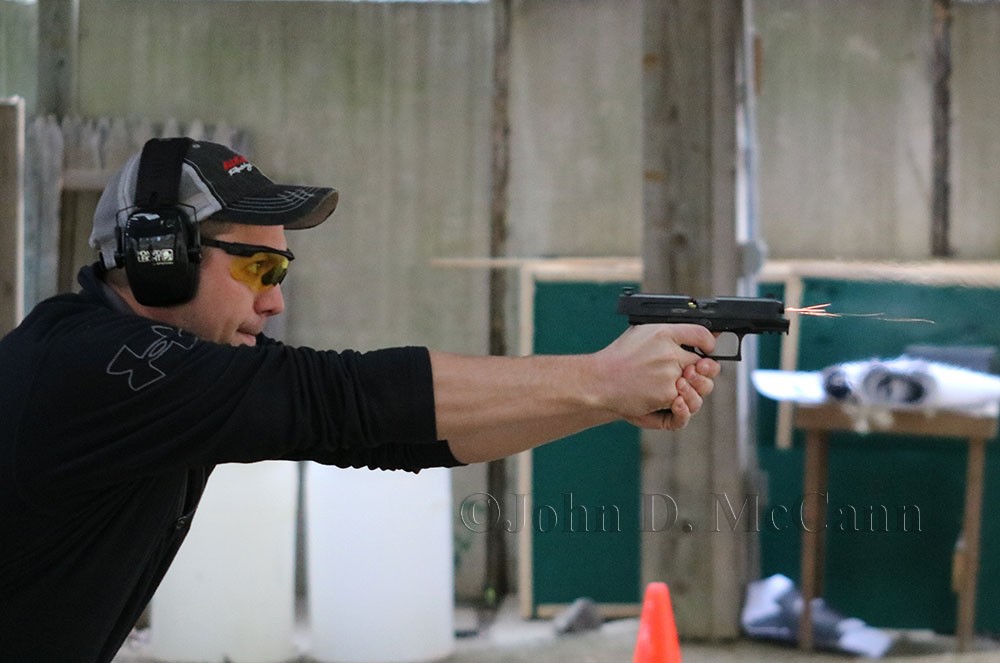 Student firing with flames leaving the barrel of his handgun.
Student firing with flames leaving the barrel of his handgun.
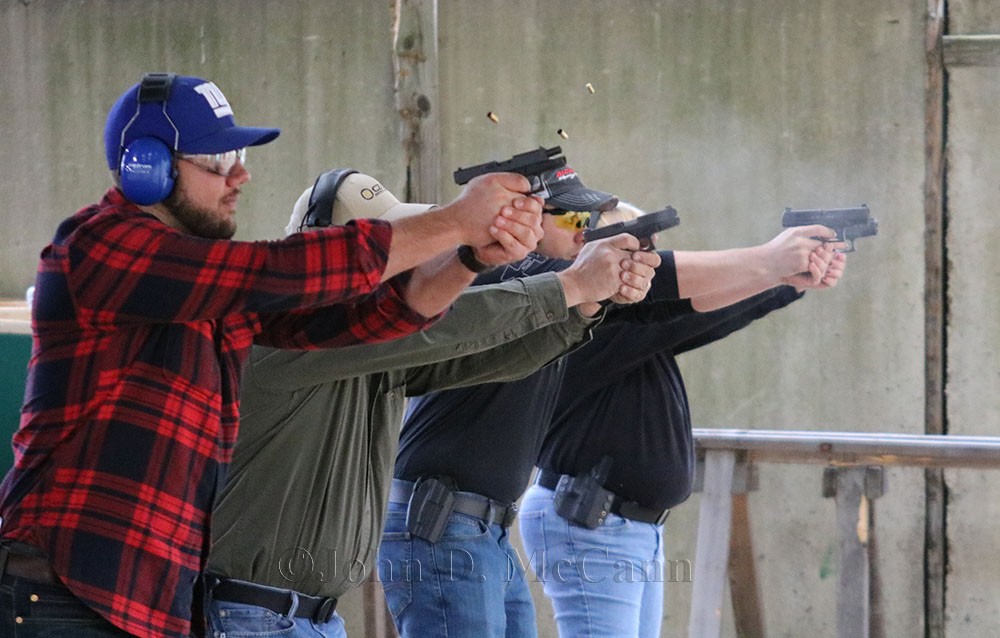 All students on line showing brass and smoke.
All students on line showing brass and smoke.
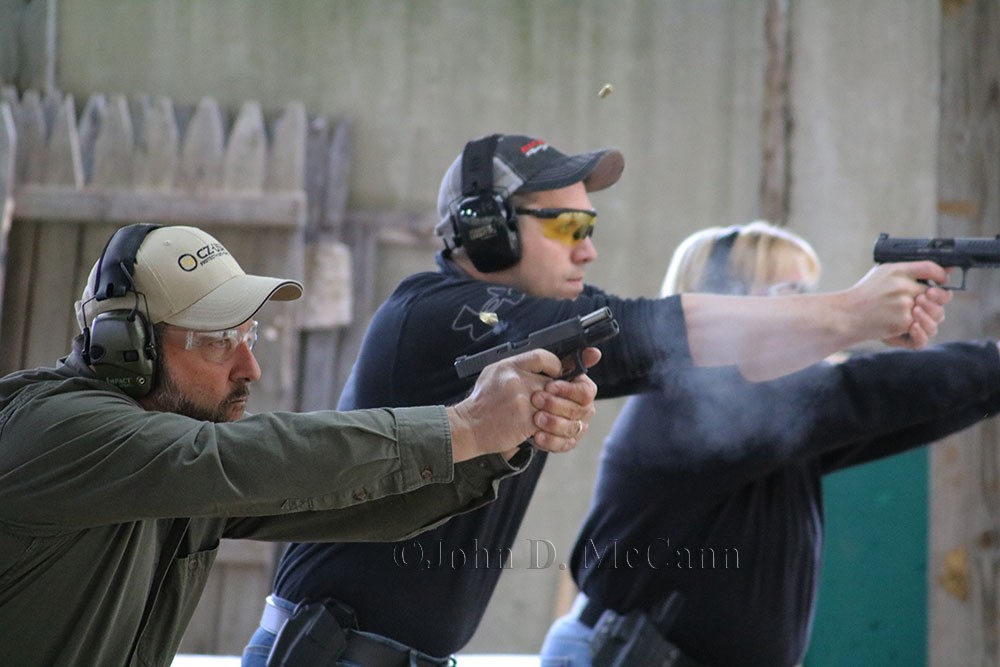 Students show intense concentration as brass flies.
Students show intense concentration as brass flies.
As with all movement techniques, students learned that their first move was to get out of the line of force for their own self preservation, then engage the attacker while safely moving. Drills were performed in "Proactive Forward Movement," "Reactive Rearward Movement," "Contact Distance Shooting," "Confrontational Distance Shooting," "Turns and Pivots," "Multiple Target Engagement With Movement," and "One Hand Shooting Techniques."
The "Confrontational Distance Shooting" is an important part of the Defensive Handgun Course. This technique is used at a distance of about three to six feet, known as the "Gun Grab Distance." The student learns that during the draw stroke from the holster, the dominant hand remains in contact with their body, as it slides to the center of the chest. The support hand completes the two handed grip vertically indexed under the operators nose, as close to the body as possible while still maintaining a proper grip. This is considered the weapon retention position. This technique is used at close quarters distances where full extension of the weapon might result in possibly being disarmed.
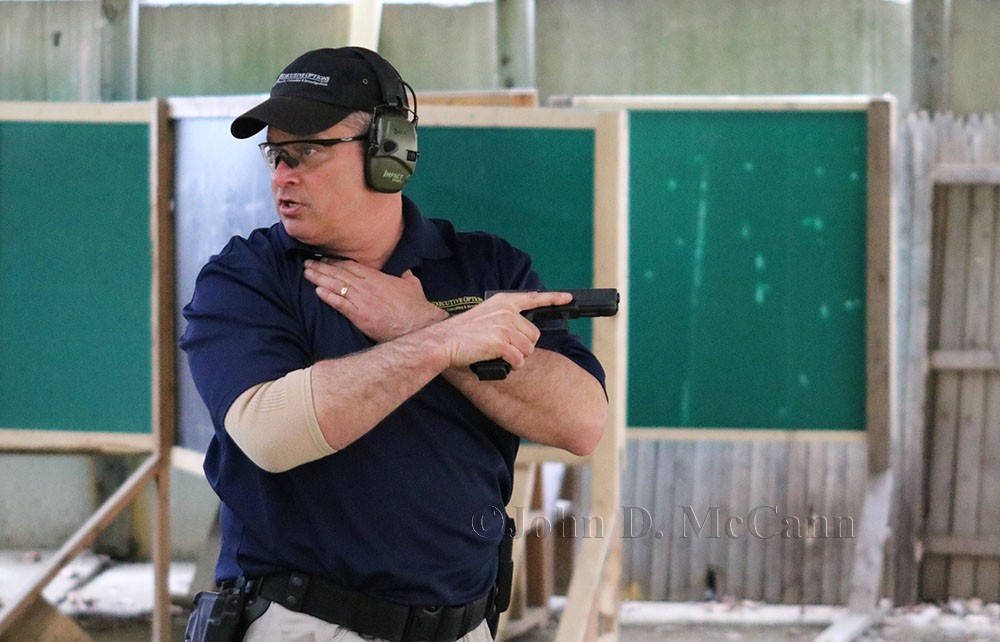 Don Redl, Jr. demonstrating the index position and 360 degree awareness.
Don Redl, Jr. demonstrating the index position and 360 degree awareness.
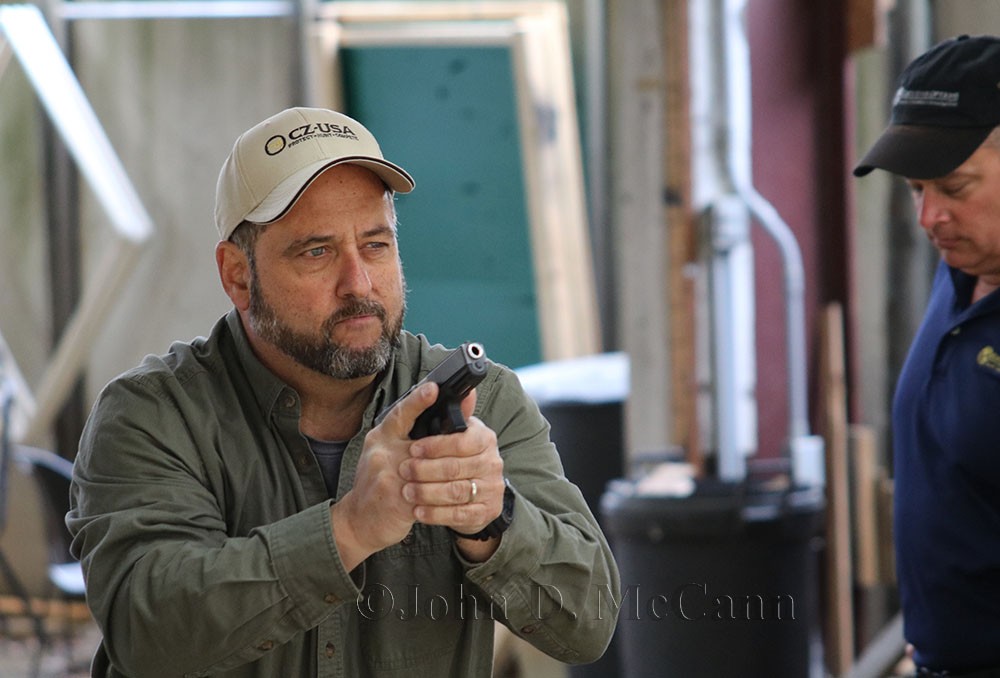 Student coming out towards the target from the weapon retention position.
Student coming out towards the target from the weapon retention position.
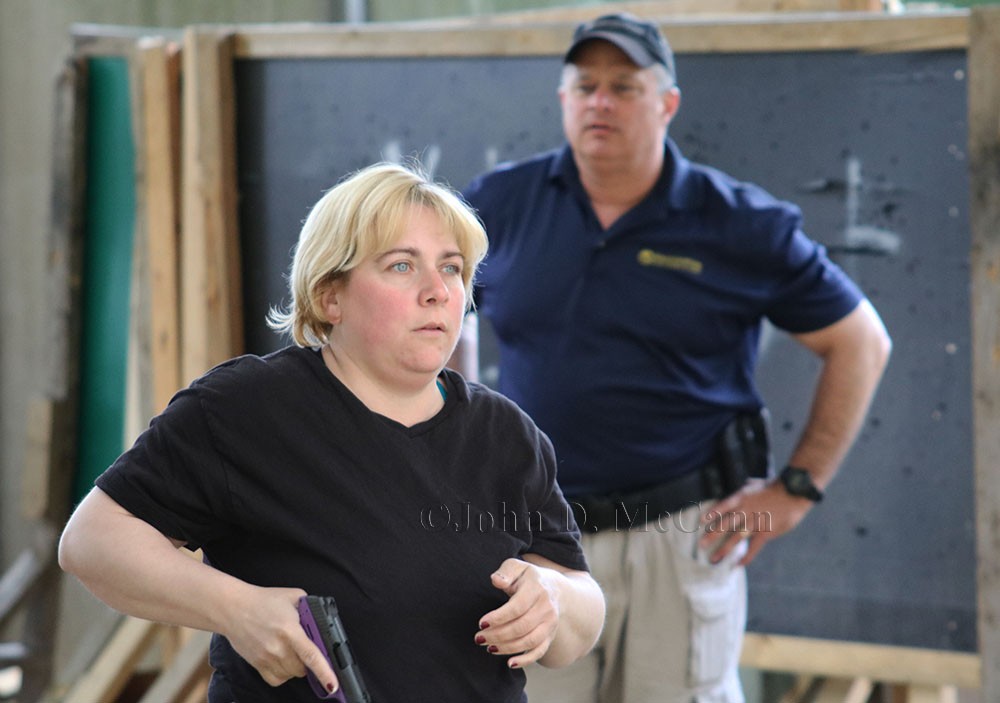 Student transitioning from holster to weapon retention position.
Student transitioning from holster to weapon retention position.
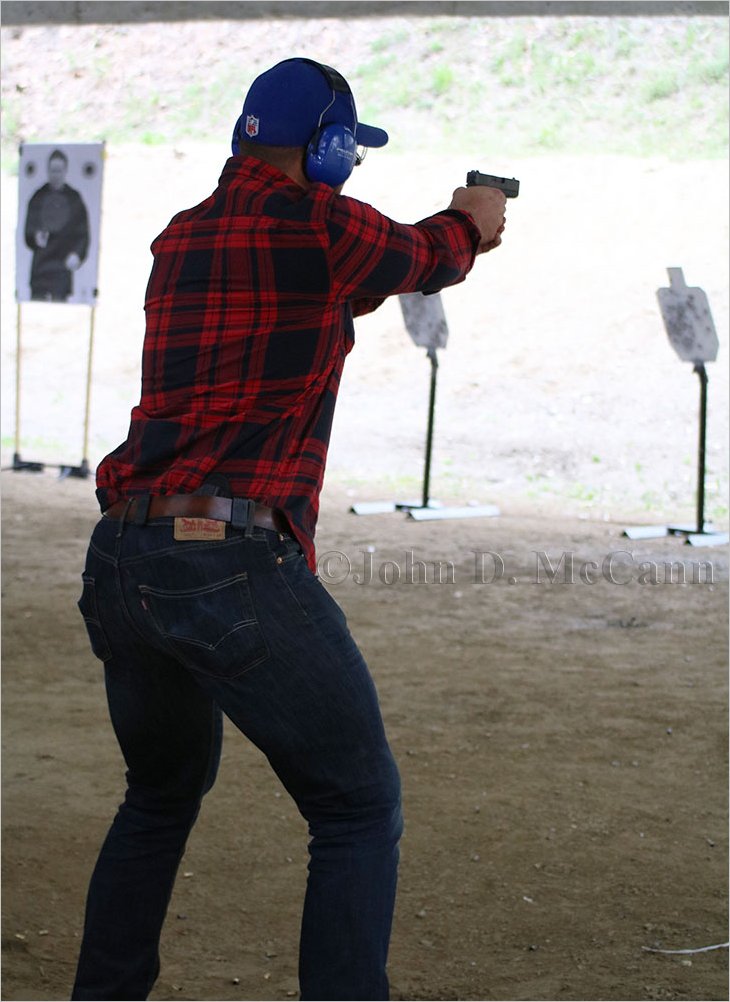 A student engaging a steel target for immediate feedback.
A student engaging a steel target for immediate feedback.
Lessons Learned
I would go into detail on each of the drills, but I don't want to give away the entire lesson plan for Don's course. However, a few important lessons learned.
The majority of gunfights occur under ten feet, and almost fifty percent under five feet. Don't present your weapon forward of the body if you are close to an assailant. Don't be in a hurry to re-holster your weapon; be sure there are no other threats before you do so.
Get off the line of force! When you move, you are being proactive, which forces the assailant to be reactive, which buys you more time. Move left or right, and never cross your legs when doing so.
When transitioning from one target to another, move your eyes first, then your weapon, so you don't overshoot your target. Of course, there were many more lessons learned.
In Closing
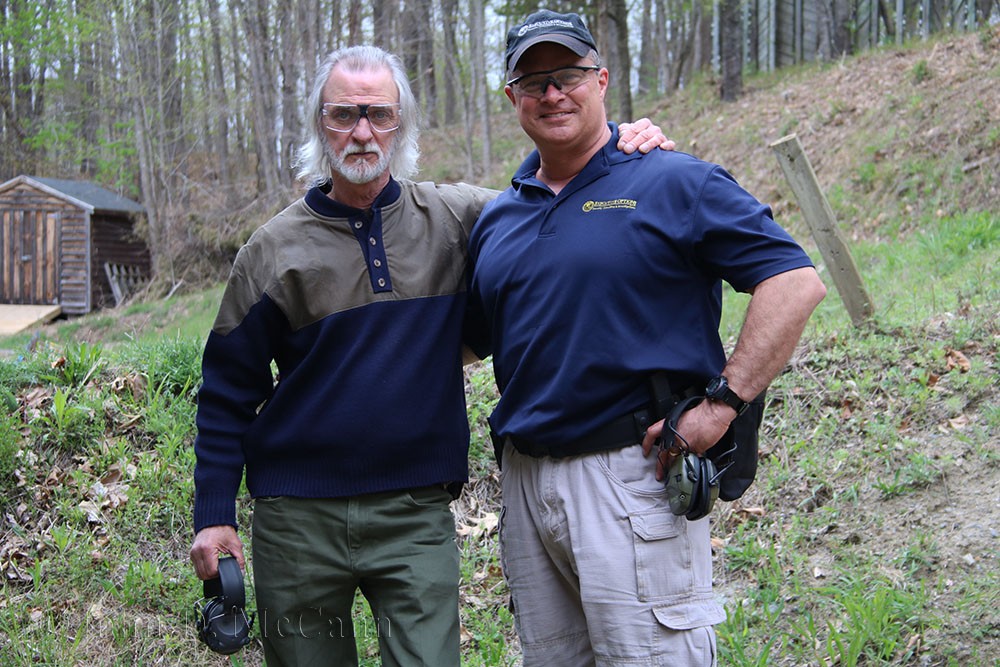 Me posing with Don Redl, Jr. after the class concluded.
Me posing with Don Redl, Jr. after the class concluded.
Overall, I felt the course was excellent and student feedback indicated that they had not anticipated learning as many skills as they did. They all felt they had become much more comfortable with the use of their handgun and were much more confident with its use, especially if they had to use it to defend themselves.
As I indicated at the beginning of this article, I feel that if someone is going to carry a handgun for defense they should get some real training. Shooting a paper target at a range will help with your accuracy, but will not prepare you for a real world defensive situation. Get some serious training from a competent instructor. It just might save your life.
Keep in mind that these photos are only a few of over a thousand I shot that day. Hopefully they give you a flavor of the training that occurred.
We hope you enjoyed this article and will help support our efforts by checking out our products. As always, Be Prepared To Survive!
Copyright © 2016 by John D. McCann
NOTE: If you are in New York and are looking for serious defensive handgun training, contact Don Redl, Jr. at Executive Options LLC. He can be contacted at don@executiveoptionsllc.com, or by phone at 917-565-5197.

